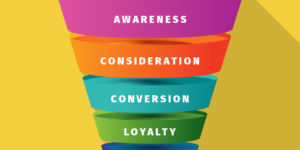Understanding Funnels in Internet marketing
Understanding Funnels in Internet marketing
Blog Article
In the whole world of digital marketing, a "funnel" can be a metaphor used to describe your way that potential customers go through as soon as they become aware of your product or service to begin making a purchase. The concept of the funnel is important for marketers because it helps them comprehend the various stages with the buyer's journey, optimize their marketing strategies, and eventually increase conversions. This article will explore the constituents of a online marketing funnel, its stages, and just how businesses can effectively put it to use to boost their marketing efforts.
What is a Digital Marketing Funnel?
An electronic digital marketing funnel represents the various stages that the consumer goes through before making an order. It is called a funnel because it starts with an extensive audience towards the top and narrows down to a smaller group who complete the required action, such as making a purchase, at the end. The funnel is normally divided into several stages, each representing a step in the customer's journey.
The Stages of your Digital Marketing Funnel
1 Awareness: This is the top of the funnel (TOFU), where prospective customers first discover your brand, product, or service. At this stage, the goal would be to attract because as possible. Marketing strategies for this stage include content marketing, social networking advertising, SEO, and paid advertisements.
2 Interest: Inside the interest stage, potential customers have shown curiosity about what you offer. They may have visited your internet site, followed you on social media, or subscribed to your newsletter. The goal here is to provide valuable information that addresses their demands or piques their interest further. This can be accomplished through blog articles, informative videos, and engaging social media content.
3 Consideration: Only at that middle of the funnel (MOFU) stage, potential prospects are considering if they should purchase your product or service. They are comparing options and looking more detailed information. Marketing efforts should give attention to demonstrating why your product or service is the best choice. Tactics include case studies, testimonials, webinars, and detailed product descriptions.
4 Intent: Customers at the intent stage take presctiption the verge of creating a purchase decision. They own added products to their cart or requested a demo. The goal is to convince these to take the final step. Personalized emails, special deals, and retargeting ads work strategies at this stage.
5 Purchase: This is the bottom of the funnel (BOFU), in which the customer helps make the actual purchase. It's imperative to ensure a seamless and positive purchasing experience. Providing multiple payment options, clear calls to action, and ideal customer support can help close the sale.
6 Loyalty: Post-purchase, the focus shifts to retaining customers and encouraging repeat business. Building loyalty involves maintaining a powerful relationship through follow-up emails, loyalty programs, and exceptional customer care. Happy company is more likely to become repeat buyers and brand advocates.
7 Advocacy: The final stage is where loyal customers become brand advocates, promoting your product or service to others. This is often encouraged through referral programs, reviews, and social networking engagement.
Optimizing Each Stage with the Funnel
Optimizing an electronic digital marketing funnel takes a tailored approach for each stage. Here are some strategies to enhance performance at each level:
• Awareness: Make use of a mix of content marketing, SEO, and social networking campaigns to achieve a wide audience. Create high-quality, engaging content that addresses your audience's pain points and interests.
• Interest: Build relationships potential customers through marketing with email, retargeting ads, and social media marketing interactions. Provide valuable resources including ebooks, whitepapers, and informative blog articles.
• Consideration: Offer detailed product information, comparisons, and user-generated content like reviews and testimonials. Host webinars and live demos to showcase your product's benefits.
• Intent: Use targeted offers, personalized messaging, and incentives to encourage conversions. Ensure your website is user-friendly and the checkout process is smooth.
• Purchase: Provide excellent customer service and ensure a hassle-free purchase experience. Follow up with thank-you emails and post-purchase support.
• Loyalty: Implement loyalty programs and engage customers through regular updates and exclusive offers. Solicit feedback and act on it to enhance your product and repair.
• Advocacy: Encourage satisfied people to share their experiences. Offer referral bonuses making it easy to allow them to leave reviews and testimonials.
Measuring and Analyzing Funnel Performance
To effectively run a digital marketing funnel, it’s essential to measure and analyze performance each and every stage. Key performance indicators (KPIs) vary with respect to the stage but could include metrics like web site traffic, click-through rates, conversions, average order value, and customer lifetime value.
Tools like Google Analytics, CRM systems, and marketing automation platforms can offer valuable insights into how well each stage of one's funnel is performing. Regular analysis helps identify bottlenecks and areas for improvement, enabling you to refine your methods for better results.
Conclusion
A well-constructed digital marketing funnel is a powerful tool for guiding prospective customers through their buying journey and converting them into loyal advocates. By knowing the different stages of the funnel and optimizing each one of these, businesses can grow their marketing efforts, improve customer experience, and drive growth. Because the digital landscape will continue to evolve, staying adaptable and responsive to changes in consumer behavior is essential to maintaining an efficient marketing funnel.